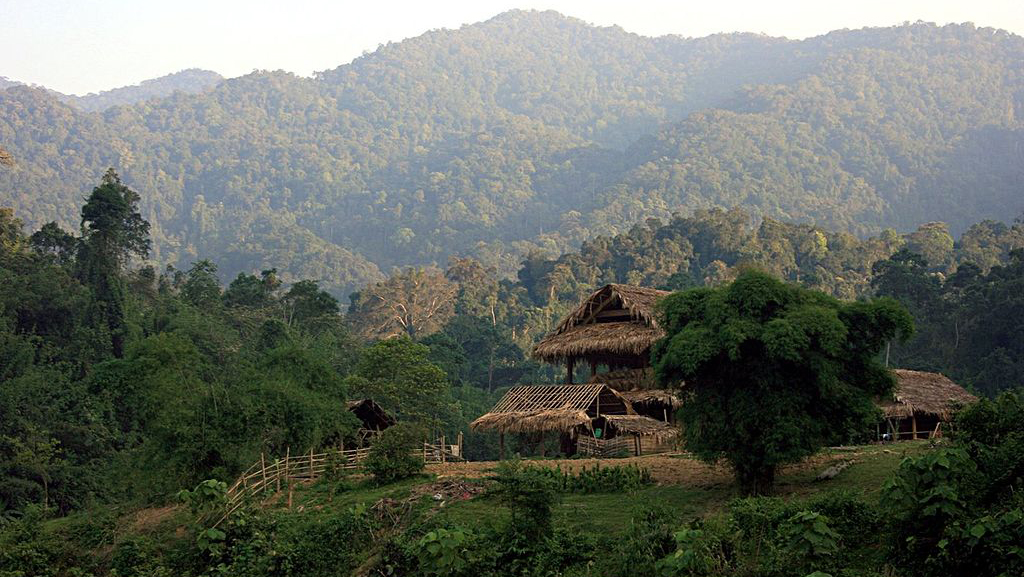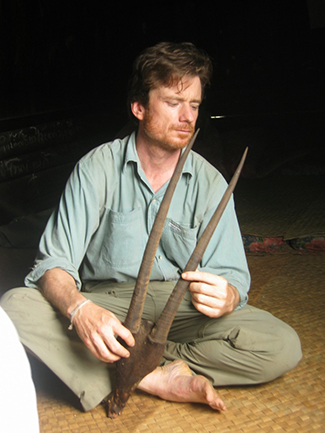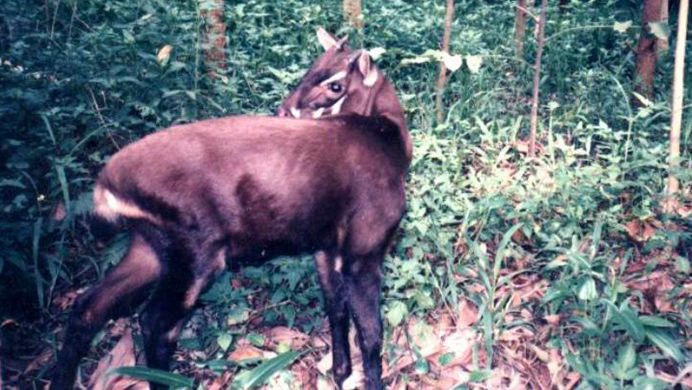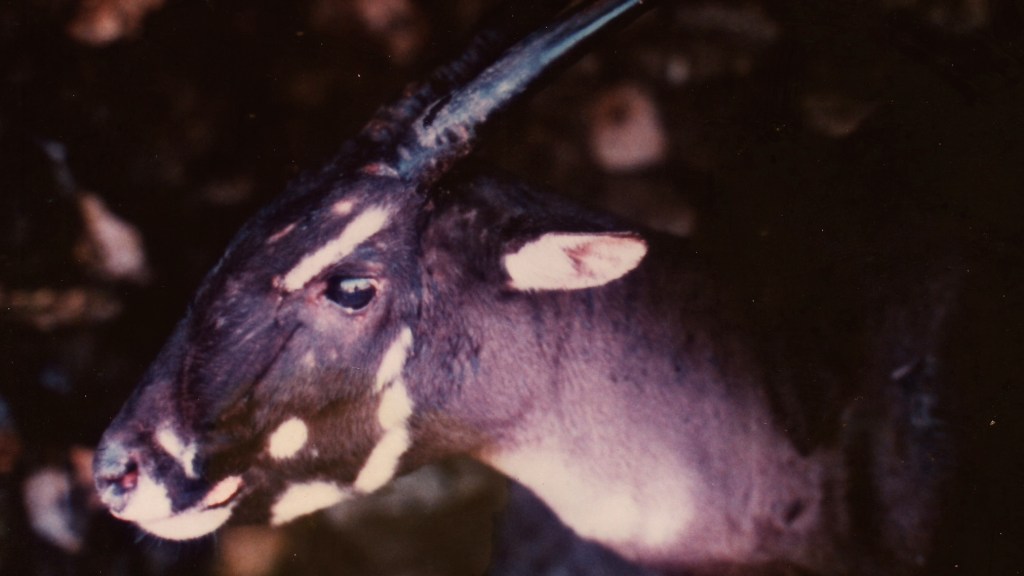The saola is the largest terrestrial mammal never seen alive in the wild by a biologist. This is not a Bigfoot story. The saola undeniably exists. It roams only in the Annamite Mountains of Laos and Vietnam.
Biologists know very little about the saola. But one thing is clear: They are in big trouble. A poaching crisis in the Annamite Mountains is hammering wildlife, and a rare species like saola stands little chance in a landscape literally covered in snares.
But how do conservationists protect a species that scientists have not even seen in its native habitat? The challenge is monumental. It is, essentially, trying to save a unicorn.
The Remarkable Story of the Saola
Bill Robichaud, is one of the world’s experts on saola. At a lecture he gave at Zoo Boise – a funder of saola conservation – he began by attesting that being a saola expert should come with a bit of qualification.
“This could be a short talk,” he said. “We do not know much. There are no dumb questions when it comes to saola.”
But what is known is astonishing enough. In 1992, a joint biological expedition by the Vietnam Ministry of Forestry and the World Wide Fund for Nature conducted a survey in the Annamite Mountains, a global biodiversity hotspot. When a biologist visited a local village to pick up vegetables, he noticed horns hanging in a hunter’s house of an animal he didn’t recognize.

It proved not only to be a new species but a new genus. While it looks superficially like an antelope or perhaps a wild ox, there really are no comparisons. “This is not like a new species of deer or new species of wild goat. The saola was something entirely new,” says Robichaud, who works for the organization Global Wildlife Conservation and now heads the IUCN’s Saola Working Group.
The Annamite Mountains proved to be a biological treasure trove, with other major wildlife discoveries including the bare-faced bulbul, large-antlered muntjac and Annamite striped rabbit. “The saola is the most spectacular chapter of what is a remarkable story,” says Robichaud.
And the saola chapter has continued. They have since been documented on camera traps. One has been seen alive by outside biologists, but it was captured by a hunter and confined to a general’s menagerie. Robichaud, who has now made significant expeditions to the Annamites, was able to spend time with that animal, but unfortunately it died after only 18 days in captivity.

“It was as tame as a domestic pig or goat,” he says. “It was wary of humans but never really got upset.”
Most of the information on saola has been gathered from information from local villagers and hunters. Even locals only rarely see them, and then typically when the animal is bayed by dogs. It is a solitary forest browser, and does not bother village gardens.
Population estimates vary from 30 to 300 animals, but it’s clear that the animal is in serious trouble. And there is a conservation crisis in the Annamites. “Tigers, elephants and giant pandas get a lot of conservation attention, as they should,” says Robichaud. “But the saola faces far greater risks. There is a scarcity of conservation attention, and this is a large mammal that is genetically distinct.”
From Bombs to Snares: Saola Under Siege
Biologists don’t know how common saola once were, but as with many wildlife species in Southeast Asia, its populations likely suffered greatly during the Vietnam War. During the conflict, Laos became the most bombed country per capita in human history; more bombs rained down on it than on all of Europe during World War II.
This, coupled with defoliation by Agent Orange, likely directly killed saola and fragmented its habitat. Where the distribution of saola is most patchy correlates to areas with the heaviest bombing.
Today, the saola faces a seemingly low-tech threat: snares. A mind boggling number of snares. Hundreds of thousands of wire traps strung across the Annamite Mountains.

“This is not local people hunting for food,” says Robichaud. “It is poaching for the Chinese medicinal trade and high-end bushmeat restaurants. The demand for anything valued for traditional medicine or meat has stimulated a catastrophe.”
A tiger can fetch $10,000 on the market, a golden coin turtle upwards of $20,000.
But the saola? Zero. Since they never existed in China or outside the Annamites, they play no role in traditional medicine.
But snares are indiscriminate killers; in some forest areas, nearly every conceivable path is blocked with a trap. “On the one hand, this is incredibly sad. Saola are bycatch, like dolphins in tuna nets,” he says. “But on the other hand, poachers are not racing us to get the last saola like they are tigers and rhinos.”
Silver Linings
Unlike many wildlife conservation stories, this is not a habitat issue. There is still plenty of forest in Laos. While poaching is a difficult problem to tackle, villagers have been huge allies.
“Engaging villagers in saola conservation is very easy,” says Robichaud. “They don’t even eat their crops. People are very open to the message.”

Many villagers are now taking pride in this endemic animal. Robichaud tells the story of a hunter who asks him about how many saola are in the United States, with all its conservation programs, or Africa, with its great herds. “When I told him they are not even found in Thailand, not even found in other parts of Laos, you could see the realization,” Robichaud says. “Later I heard that he his dogs had bayed a saola and he chose not to kill it.”
With the leadership of local people and support from zoos and other organizations, a massive snare collection effort is underway. More than 130,000 snares have been collected and destroyed at five key sites since 2011. “When you collect that many snares, you’re helping a lot of other wildlife, too,” he says.
Robichaud visited Zoo Boise to meet with Zoo Teens, a group of young people who volunteer at the zoo and raise money for conservation programs. Their focus has been on funding snare removal in the Annamites. (Full disclosure: my wife works for Zoo Boise).
“Having young people raise awareness and fund our efforts makes a huge difference,” says Robichaud. “People don’t know about the saola. It faces daunting challenges. But it is a challenge where we can make a difference.”




I really enjoy all of your articles, and once I get started, I keep clicking links to another of your articles, and down the rabbit hole I go, haha! This one was particularly fascinating for me! Thank you 🙂
Hi Danelle,
Thanks for the very kind comment! I am glad you enjoy the articles.
Best,
Matt
You call them large, but their actual size is never mentioned. How “large” are they?
Thank you very much for this essay on Saolas. Had never heard of them. Keep up the good work!
how do people help save the saola
can we still save the saola
and there are still so many who care not at all…perhaps true enlightenment is only opening ones eyes to the beauty that surrounds us…not for the purpose of extracting every cent from something, but more in the way some music stirs the soul. is nature just music come to life? many times it appears to be just that. the work that needs to be done by so many is really very simple, just look, listen, revel in the world, and become a part of it…a protector…
Is the Saola, not by chance related to the Okapi? They look similar, see a photograph on this link: http://www.allears.net/tp/ak/okapi2.jpg
Dear Dr. Miller,
We have some questions.
How is it called largest terrestrial mammal when nobody has seen it ?
Indian Gaur is certainly bigger than Saola. We can send the measurements for that matter.
Would greatly appreciate your feedback on this.
Hi Jayant, It is the largest terrestrial mammal that no scientist has seen in the wild — not the largest terrestrial mammal of all. Thank you for your interest!
A very insightful article thank you!
How large is the area where the saola may be found?Larger or smaller than Texas?
Smaller! The Annamite Mountains where the Saola is located stretches approx. 1,100 km, while texas is approx. 1,300 km wide. Despite being relatively small, the area is known for its biodiversity!
The picture I see does not show that this is as large as the giant eland or the elephant. Sad that this unknown mammal is highly threatened.
This article refers to “the Chinese medicinal trade and high-end bushmeat restaurants” and “traditional medicine”.
I think it’s time to rethink the impact such terminology has on the audience. Both phrases implicitly sanction the practice that the surrounding text appears to condemn. Medicine is good, it makes sick people well, or enhances an individual’s general wellbeing. “High-end” similarly refers to something special, the sort of good or service that would be highly valued/desirable.
In both cases the terminology confuses and indeed white washes the truth.
I would suggest the adoption of the simple phrase “for human consumption”, possibly with the modifier “principally in , , … and “.
So, for example, your paragraph would read:
“This is not local people hunting for food,” says Robichaud. “It is poaching for human consumption, principally in China. This demand has stimulated a catastrophe.”
Of course this example changes the quoted words of Dr. Robichaud – I use it only as an example.
Please, let’s do away with any implication that killing these creatures serves any human necessity. Drinking rhino horn tea or whatever never cured anybody – not even of impotence.
My very best regards, and thanks for a great article!
That is really wonderful – and congratulations to the youth at Zoo Boise for undertaking to raise funds for this animal. Good wishes for your continued success in collecting the snares and hopefully saving a rare species.
very nice story and great job. Ya….there are a number of species in the worldwide which is not yet discovered while threatened, even some of them extinct before they discovered.
How large are the saola?
Adults weigh 80-100 kg: http://www.savethesaola.org/the-saola/what-is-a-saola/